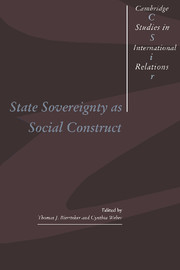Book contents
- Frontmatter
- Contents
- List of figures
- List of contributors
- Acknowledgments
- 1 The social construction of state sovereignty
- 2 Contested sovereignty: the social construction of colonial imperialism
- 3 Beyond the sovereignty dilemma: quasi-states as social construct
- 4 The sovereign state system as political-territorial ideal: historical and contemporary considerations
- 5 Sovereignty and the nation: constructing the boundaries of national identity
- 6 Sovereignty, nationalism, and regional order in the Arab states system
- 7 Binding sovereigns: authorities, structures, and geopolitics in Philadelphian systems
- 8 Hierarchy under anarchy: informal empire and the East German state
- 9 Reconstructing the analysis of sovereignty: concluding reflections and directions for future research
- Index
- Titles in the series
5 - Sovereignty and the nation: constructing the boundaries of national identity
Published online by Cambridge University Press: 01 June 2011
- Frontmatter
- Contents
- List of figures
- List of contributors
- Acknowledgments
- 1 The social construction of state sovereignty
- 2 Contested sovereignty: the social construction of colonial imperialism
- 3 Beyond the sovereignty dilemma: quasi-states as social construct
- 4 The sovereign state system as political-territorial ideal: historical and contemporary considerations
- 5 Sovereignty and the nation: constructing the boundaries of national identity
- 6 Sovereignty, nationalism, and regional order in the Arab states system
- 7 Binding sovereigns: authorities, structures, and geopolitics in Philadelphian systems
- 8 Hierarchy under anarchy: informal empire and the East German state
- 9 Reconstructing the analysis of sovereignty: concluding reflections and directions for future research
- Index
- Titles in the series
Summary
The historic idea of a unifying American identity is now in peril in many arenas – in our politics, our voluntary organizations, our churches, our language.…
(Arthur M. Schlesinger, Jr. 1992)Something unique is afoot in Europe, in what is still called Europe even if we no longer know very well what or who goes by this name. Indeed, to what concept, to what real individual, to what singular entity should this name be assigned today? Who will draw up its borders?
(Jacques Derrida, 1992)These opening quotes suggest that scholars as diverse as Schlesinger and Derrida sense all is not well with sovereign national identities. They refer specifically to America and Europe, but the issue has much broader resonance. The names Europe and America could be replaced in these passages with Britain, Germany, France, and many other names given to nation-states, and still retain the sense of the two quotes. The instability of national identities recently has attracted attention in both academic and nonacademic circles. Within the mainstream of orthodox international relations, however, there is little interest in this topic. By conceptualizing the state as a given, unitary entity, the dominant realist approach has undermined the distinction between state, nation, and sovereignty. This permits questions of national identity and its relevance to sovereignty to be dismissed because they are presumed not to be problems.
This is an increasingly unsatisfactory point of view.
- Type
- Chapter
- Information
- State Sovereignty as Social Construct , pp. 121 - 147Publisher: Cambridge University PressPrint publication year: 1996
- 53
- Cited by



